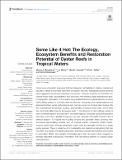Files in this item
Some like it hot : the ecology, ecosystem benefits and restoration potential of oyster reefs in tropical waters
Item metadata
| dc.contributor.author | Richardson, Marina A. | |
| dc.contributor.author | Zhang, Ya | |
| dc.contributor.author | Connolly, Rod M. | |
| dc.contributor.author | Gillies, Chris L. | |
| dc.contributor.author | McDougall, Carmel | |
| dc.date.accessioned | 2023-03-16T13:30:04Z | |
| dc.date.available | 2023-03-16T13:30:04Z | |
| dc.date.issued | 2022-06-23 | |
| dc.identifier | 283593411 | |
| dc.identifier | 96186801-c646-4736-8700-fd7e5b7ec86b | |
| dc.identifier | 85134060261 | |
| dc.identifier.citation | Richardson , M A , Zhang , Y , Connolly , R M , Gillies , C L & McDougall , C 2022 , ' Some like it hot : the ecology, ecosystem benefits and restoration potential of oyster reefs in tropical waters ' , Frontiers in Marine Science , vol. 9 , 873768 . https://doi.org/10.3389/fmars.2022.873768 | en |
| dc.identifier.issn | 2296-7745 | |
| dc.identifier.uri | https://hdl.handle.net/10023/27203 | |
| dc.description | Funding: Open access funds provided by Griffith University. | en |
| dc.description.abstract | Oysters are ecosystem engineers that form biogenic reef habitats in shallow coastal and estuarine waters and provide important ecosystem services. Widespread global declines have triggered a world-wide restoration movement, however a paucity of information on tropical oyster reefs has resulted in their exclusion from existing global assessments and, consequently, restoration. In this review we quantified the known global diversity of native reef-building oysters to compare diversity between temperate and tropical regions and assessed historic oyster reef presence and declines using two tropical case studies. We then summarised the biology, ecology, and benefits of tropical oyster reefs, which have four functional differences to temperate reefs: 1) the diversity of reef-building oysters is over four times higher in tropical than in temperate regions; 2) tropical reef-building oysters can have continuous spatfall throughout the year whereas temperate species have a defined season; 3) tropical reef-building oysters are generally faster growing than temperate reef-building oysters; and 4) tropical oysters commonly create mixed-species oyster reefs whereas temperate oyster reefs are generally formed by a single oyster species. There is evidence of unsustainable and destructive harvesting that has resulted in the decline of tropical oyster reefs, and these reefs should therefore be included in restoration efforts. We highlight knowledge gaps that can guide future research to develop important foundational information that will remove barriers to tropical oyster reef restoration. | |
| dc.format.extent | 15 | |
| dc.format.extent | 3561500 | |
| dc.language.iso | eng | |
| dc.relation.ispartof | Frontiers in Marine Science | en |
| dc.subject | Ecosystem services | en |
| dc.subject | Multi-species restoration | en |
| dc.subject | Oyster diversity | en |
| dc.subject | Oyster reef restoration | en |
| dc.subject | Reef-building oysters | en |
| dc.subject | Tropical oyster reefs | en |
| dc.subject | Tropical oysters | en |
| dc.subject | Tropical restoration | en |
| dc.subject | GE Environmental Sciences | en |
| dc.subject | QL Zoology | en |
| dc.subject | Aquatic Science | en |
| dc.subject | Oceanography | en |
| dc.subject | Ocean Engineering | en |
| dc.subject | Environmental Science (miscellaneous) | en |
| dc.subject | Global and Planetary Change | en |
| dc.subject | Water Science and Technology | en |
| dc.subject | MCC | en |
| dc.subject.lcc | GE | en |
| dc.subject.lcc | QL | en |
| dc.title | Some like it hot : the ecology, ecosystem benefits and restoration potential of oyster reefs in tropical waters | en |
| dc.type | Journal item | en |
| dc.contributor.institution | University of St Andrews. School of Biology | en |
| dc.identifier.doi | https://doi.org/10.3389/fmars.2022.873768 | |
| dc.description.status | Peer reviewed | en |
This item appears in the following Collection(s)
Items in the St Andrews Research Repository are protected by copyright, with all rights reserved, unless otherwise indicated.

